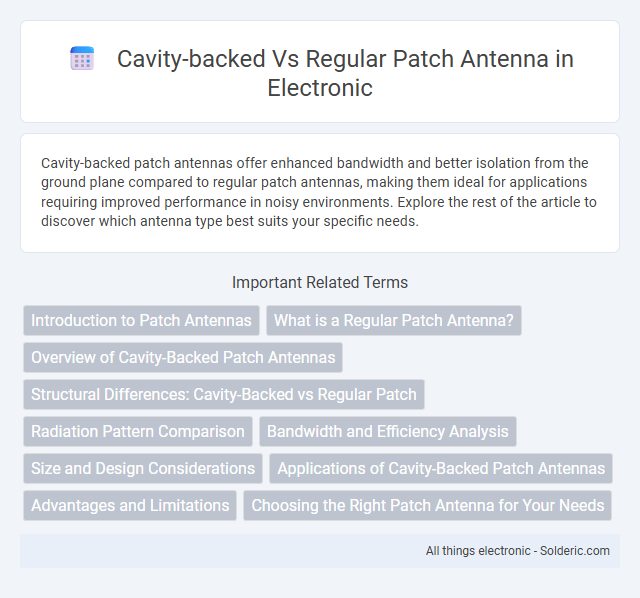Cavity-backed patch antennas offer enhanced bandwidth and better isolation from the ground plane compared to regular patch antennas, making them ideal for applications requiring improved performance in noisy environments. Explore the rest of the article to discover which antenna type best suits your specific needs.
Comparison Table
| Feature | Cavity-Backed Patch Antenna | Regular Patch Antenna |
|---|---|---|
| Structure | Patch mounted with metal cavity backing | Simple flat patch on dielectric substrate |
| Bandwidth | Wide, typically 10-20% relative bandwidth | Narrow, typically 2-5% relative bandwidth |
| Gain | Higher gain due to cavity resonance | Moderate gain |
| Efficiency | Higher efficiency by reducing surface wave losses | Lower efficiency due to substrate losses |
| Size | Bulkier due to cavity; larger volume | Compact and low profile |
| Complexity | More complex fabrication and assembly | Simple to fabricate |
| Applications | Radar, satellite communication requiring high performance | Wireless devices, mobile communications |
Introduction to Patch Antennas
Patch antennas consist of a flat rectangular or circular radiating element mounted over a ground plane, widely used in wireless communication due to their low profile and ease of integration. Cavity-backed patch antennas enhance performance by enclosing the patch in a metallic cavity, improving bandwidth and reducing back radiation compared to regular patch antennas. Your choice between these designs depends on application requirements such as size constraints, environmental robustness, and desired frequency performance.
What is a Regular Patch Antenna?
A regular patch antenna consists of a flat rectangular or square metallic patch mounted on a dielectric substrate over a ground plane, designed to radiate electromagnetic waves efficiently. Its simple structure allows for easy fabrication and integration into compact wireless devices, making it ideal for applications like GPS, Wi-Fi, and mobile communications. You benefit from its lightweight and low-profile characteristics, though it may have limited bandwidth and radiation efficiency compared to cavity-backed antennas.
Overview of Cavity-Backed Patch Antennas
Cavity-backed patch antennas feature a metal cavity behind the radiating patch, which enhances their bandwidth and reduces substrate losses compared to regular patch antennas. This design allows for improved isolation and better performance in high-frequency applications, making them suitable for radar and satellite communications. Your choice of antenna can significantly impact system efficiency by leveraging the cavity-backed design's superior gain and reduced surface wave excitation.
Structural Differences: Cavity-Backed vs Regular Patch
Cavity-backed patch antennas incorporate a metallic cavity beneath the radiating patch, which enhances bandwidth and reduces surface wave losses compared to regular patch antennas that have a simple dielectric substrate without an enclosed cavity. This structural difference allows cavity-backed antennas to achieve improved radiation efficiency and better isolation from the ground plane, making them ideal for high-performance applications. Understanding these distinctions can help you select the most suitable antenna for your specific communication needs.
Radiation Pattern Comparison
Cavity-backed patch antennas exhibit a more stable and directional radiation pattern with reduced back radiation compared to regular patch antennas, enhancing signal focus and minimizing interference. Regular patch antennas typically have broader beamwidths and higher side lobe levels, which may result in less efficient radiation control. Your choice of antenna affects coverage precision, making cavity-backed designs preferable for applications demanding tighter beam control and improved front-to-back ratio.
Bandwidth and Efficiency Analysis
Cavity-backed patch antennas exhibit significantly enhanced bandwidth due to the reduced surface wave losses and improved impedance matching within the cavity structure, often achieving bandwidths up to 10-15% compared to the typical 2-5% bandwidth of regular patch antennas. Efficiency in cavity-backed designs is higher as the cavity suppresses unwanted substrate modes and decreases dielectric and conductor losses, resulting in radiation efficiencies exceeding 85%, whereas regular patch antennas generally show efficiencies around 70-80%. These performance improvements make cavity-backed patch antennas suitable for applications requiring wideband and high-efficiency operation, such as radar and satellite communication systems.
Size and Design Considerations
Cavity-backed patch antennas offer improved isolation and reduced surface wave losses, resulting in enhanced radiation efficiency compared to regular patch antennas, but their size is generally larger due to the cavity structure. Regular patch antennas have a more compact and simpler design, making them suitable for applications with strict size constraints, although they may suffer from higher substrate losses and lower gain. Design considerations for cavity-backed antennas include the trade-off between increased antenna volume and improved electromagnetic performance, while regular patches prioritize minimal footprint and ease of fabrication.
Applications of Cavity-Backed Patch Antennas
Cavity-backed patch antennas are primarily used in radar systems, satellite communications, and military applications due to their enhanced bandwidth, higher gain, and improved isolation from surrounding structures. Their robust design minimizes interference and enables reliable performance in harsh environments like aerospace and defense sectors. These antennas are preferred in phased array systems where precise beamforming and thermal stability are critical.
Advantages and Limitations
Cavity-backed patch antennas offer enhanced bandwidth and improved radiation efficiency compared to regular patch antennas due to their cavity structure, which reduces surface wave losses and enhances impedance matching. However, their increased complexity and larger size can limit integration in compact devices, while regular patch antennas are simpler, more compact, and cost-effective but suffer from narrower bandwidth and lower efficiency. Your choice depends on the specific application requirements, balancing performance needs with size and manufacturing constraints.
Choosing the Right Patch Antenna for Your Needs
Cavity-backed patch antennas offer enhanced bandwidth and improved isolation compared to regular patch antennas, making them ideal for applications requiring high performance and reduced interference. Regular patch antennas are typically smaller, cost-effective, and easier to manufacture, suitable for compact devices where space and budget are critical factors. Selecting between cavity-backed and regular patch antennas depends on priorities such as gain, bandwidth, size constraints, and overall system requirements in wireless communication designs.
cavity-backed vs regular patch antenna Infographic

 solderic.com
solderic.com